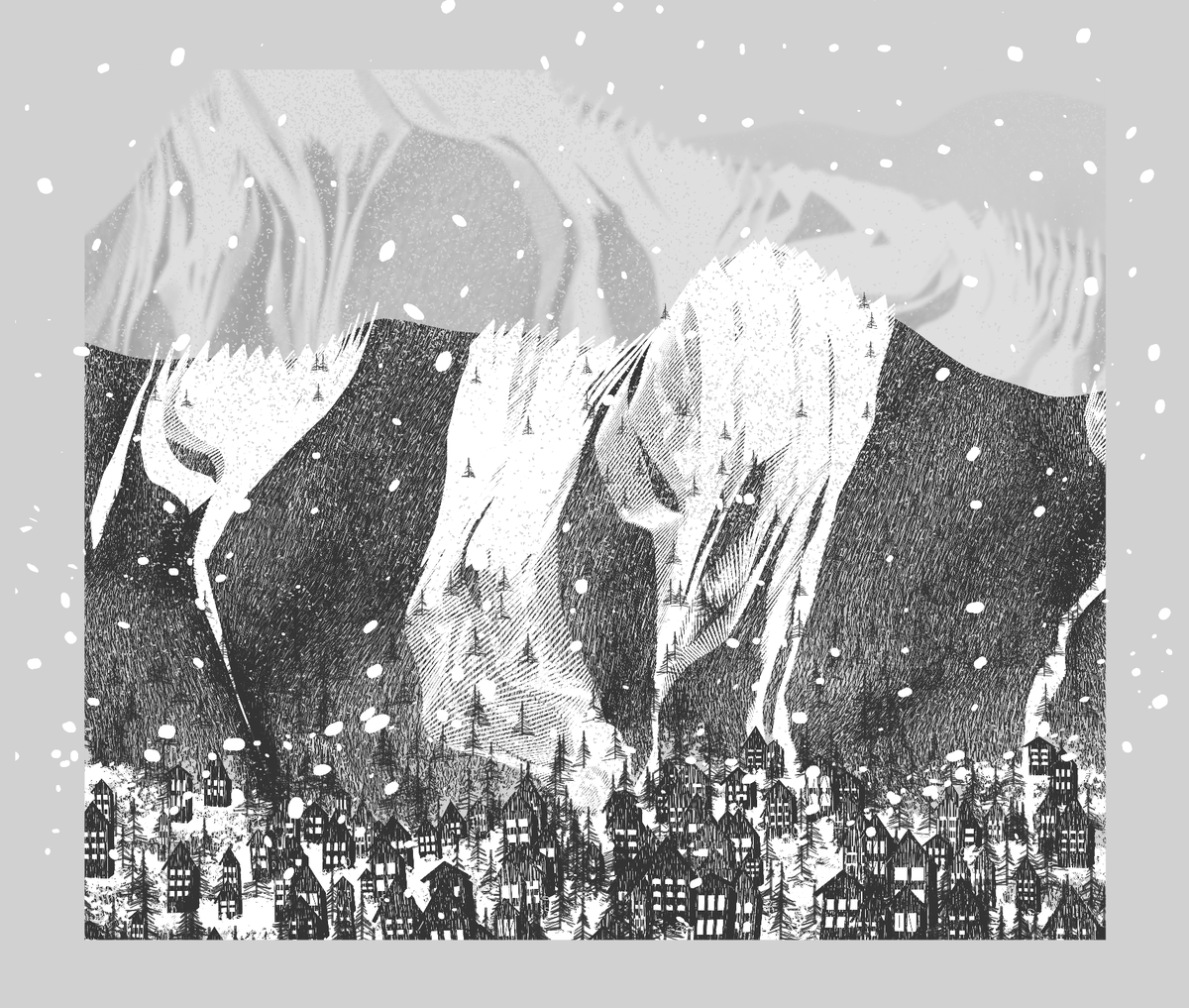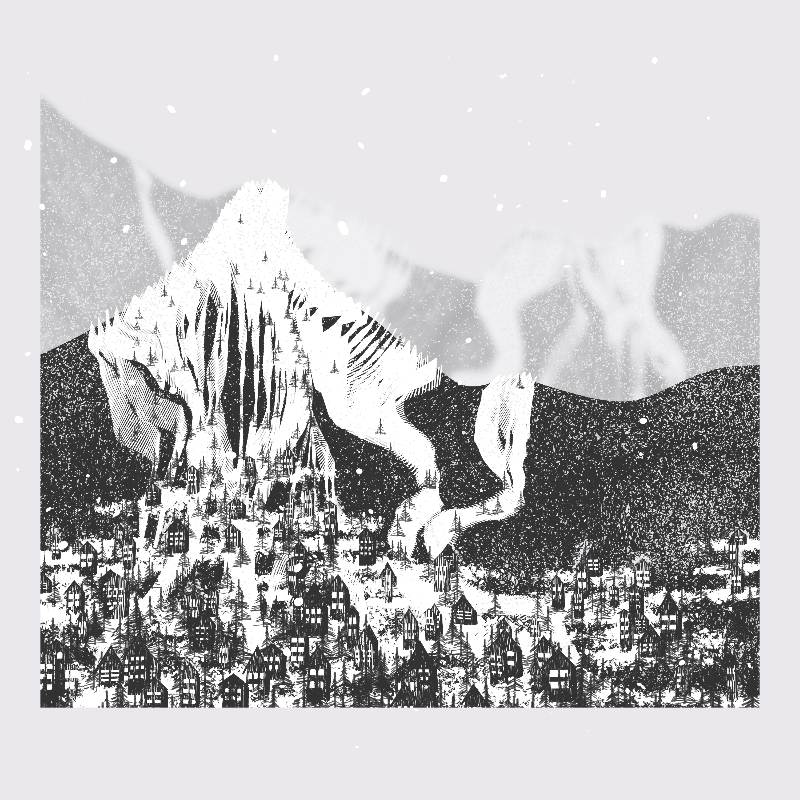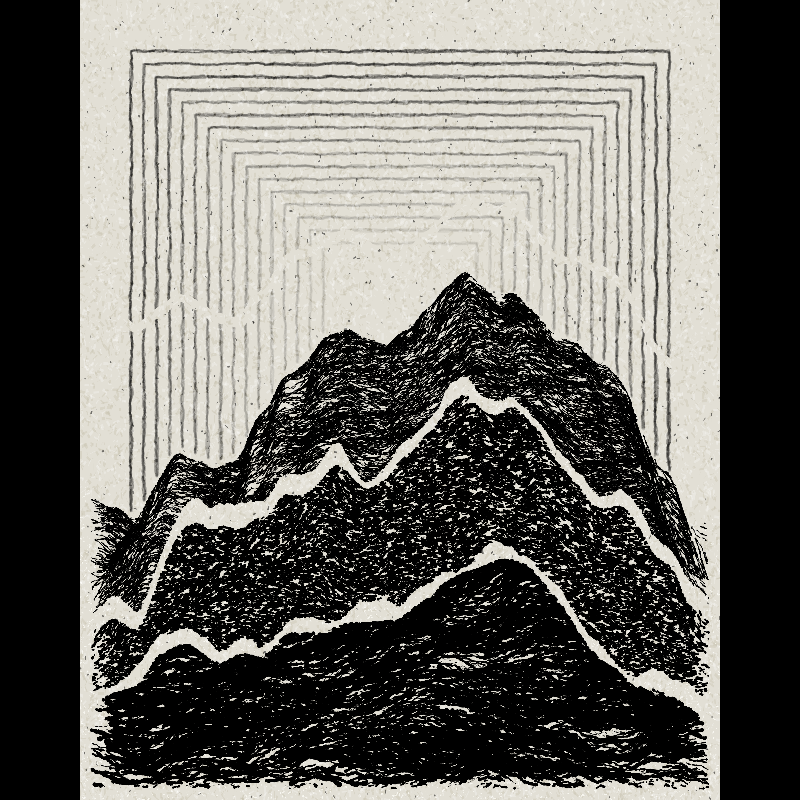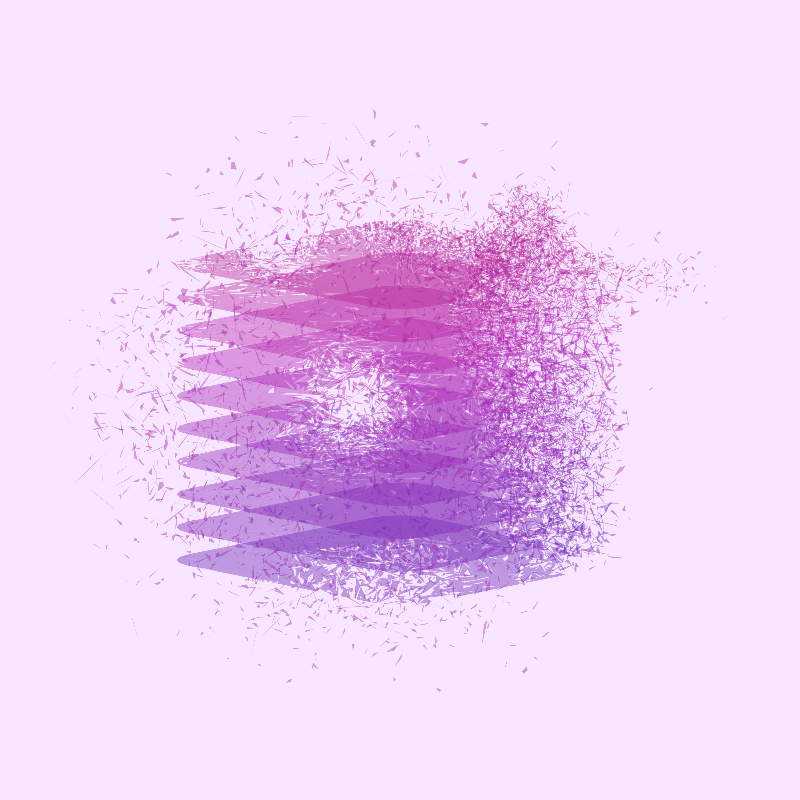
Making White Mountain Winter
written by drey
project name project name project name
In the process of making a gen art piece, I try to respect a few rules of thumb. Among them –
- Stay true to yourself and what inspires you
- If possible, try not to do anything too cliche
As it turns out, satisfying both at the same time is pretty difficult when something that inspires you is mountains.
A tool for drawing the shape of a mountain range is a staple in the toolbox, as it were. Noise. Ah, we love the noise. It gives us that smooth pseudo-randomness that is the basis for so many effects. But it’s easy for the tool to lead to contrived outcomes.
But therein lies the dissonance. I can’t suppress my love of mountains just because they look like a function. These wonderful tectonic monoliths hold a very special place in my heart.
I grew up around these mountains.
We could see them from my backyard.
When the small town ski area went bankrupt, we hiked underneath the lift just to get one run.
I hiked them in eighth grade with my class, when I had no confidence that I could.
I hiked them again and again. With friends from every walk of life.
I knocked myself out skiing, laying sprawled in the woods while my friends found me from my hat hanging in a tree overhead.
After another injury I had the dishonor of being towed down by ski patrol.
I still loved them.
I hiked them again to propose to my wife.
A few months back, I hiked them with my friends from flat places who had never seen such things. Then I spilled the rest of the hiking water on my laptop (RIP).
We laughed about it. Impossible to care while we shared an experience that approaches spiritual.
We touched grass. Just like y’all always instructed.
I hope you accept my mountain-enjoyer credentials. Now – about the project.
Color
The color for this project was sampled off of a dermatopathology slide. In fact the entire project was born from the notion that I loved this color so much, I had to do something with it. To respect it. The vibe it gave of that fading, late afternoon light in December, northern New Hampshire. Bleak and beautiful. Quickly dissolving to black.
There is some variation in the color scheme, but not too much. I found that getting too far away from this magical color lost that essential vibe that it communicated.
Beyond that, the color is pretty stark. The only other colors in use are white and a dark grey-black. I was tempted so many times to deviate from this simple scheme, but kept the disciplined approach in play. I’ve been wanting to try a pure 3-color scheme for a long time, and here we finally have it.
Forms
Back to that pesky noise. So I mentioned how a 2D noise field ends up looking something like a mountain. Nothing wrong with it, per se – but I wanted to think outside the box of how we typically construct a mountain. I wanted to develop a different kind of perspective and relationship with the subject that I’ve not yet experienced.
In this piece, instead of simple noise-based relief, I use domain warping (also noise-based, of course, but you can’t have everything...) to create the basic form that we call a mountain. Sometimes it looks like a mountain, but not always. Sometimes it looks like a random slab or a floating swatch. But we form an unspoken agreement that it represents a mountain. I declare that I wish for it to be a mountain, and you accept, or at least consent and remain open-minded that it might be.
To draw the mountain, I use a sketching or hatching technique. The mountain is divided into multiple horizontal strata, and each strata assumes a set of rules for how it should be hatched. I’ve always loved the idea of pen and ink techniques and how they might be incorporated into a digital piece. My prior project Alpinism begins to explore this with its 3 different sketching techniques.
project name project name project name
When I refer to the pen and ink idea being implemented in the digital medium, it may be done with a certain degree of realism, as above, or in a more abstract way. This piece tends toward the latter. It uses straight lines, with no attempt at variation within lines, but still respects the idea of hatching, where one straight line should originate from nearby the endpoint of another, until the target area is filled.
There are 5 levers that control the hatching algorithm: width, height, density, jitter, and warp. Each of these criteria may differ independently to create a wide range of outcomes and effects.
Some degree of additional variation is added by applying a masking field to the hatched area. This method felt more “digital-native” and more in line with the thematic approach in the rest of the project
Artifacts
I became obsessed with this idea of artifacts during the development of this piece. By artifacts, I mean: the rough edges; the imperfections; the mark of the tools on the final result as they craft it. Something I’ve recently come to accept about myself: the only thing I enjoy more than something beautiful is the destruction and dissolution of that beautiful something. Twisting and crushing and obliterating it so we can squeeze out some essence that isn’t present in the original form. I originally thought this was kind of a meme. This summer I made the piece Fantasized Telekinetic Obliteration, based on the imagined vengeful destruction of my broken air conditioning unit.
project name project name project name
But, for better or worse, it’s actually true. A theme that keeps coming back again and again. So I want to embrace it.
In this case, there are a few ways such artifacts shine through.
Forms
First, with the overall forms. They may be distorted, twisted, misshapen, and not necessarily reaching the edge of the frame, which would mask some of the illusion. The form is a plot of 2D space that is unapologetically a plot of 2D space. Edges and corners may be exposed. We may call it a mountain because of that aforementioned truce, not because we’re forced or tricked into doing so.
Snow fields
Next, with the snow fields, or trails, as some of them turn out to look. The trails are drawn with a simple line brush. I began the process by trying various ways of hiding that fact, using all sorts of more sophisticated approaches. But I always preferred this simple approach, where the process of drawing the trails shines through. I also really enjoy the cases where the drawing of a trail takes it off of the mountain entirely. Launching off into nothing. Perhaps it’s a bug. But it stays.
The trails also originate from a fixed number of evenly-spaced starting points at the top of the field. Some grids are coarser, others more fine. But either way, the touch of the machine is preserved. I considered hiding the rough origination points, or masking them according to the shape of the hillside, but I preferred to leave them alone, like brush strokes.
The trails generally flow according to the same field that helped to draw the land mass, which provides some continuity between the elements. But they also deviate according to a second applied field. This helps the trails feel lively and interesting, while also respecting the underlying topography.
Trees
I’ll also count the trees as contributing to this idea, because they are more or less straight, rather than warped or curved along with their surroundings. I played around with the idea of distorting or varying the shape of the trees, but purposely settled on this “stamped” look because it gives that contrast. Flowing, drawn elements against an assembly line. It reveals the process of a little tree generator machine going *stamp stamp stamp*, which indeed is exactly what happens. No qualms about realism, but rather embracing a sort of mixed-media approach to assembling the landscape.
Houses
For the houses I used a simplified drawing and hatching approach. I wanted the houses to have a somewhat childlike quality to them. For me, this helped to resonate with this memory which originates in childhood. Indeed, halfway through this project, I experimented with the idea of making the houses much more detailed and hi-fi.
Unfortunately, as it sometimes happens with experimental ideas, it wasn’t meant to be. Making the houses too realistic took away that roughly-drawn quality that I wanted to preserve. Instead, we have simple structures with intentionally forced perspective.
Each home also emits its own snow-yard when drawn, which can contribute to different effects depending on where it’s located, and what elements are underneath or nearby. On one hand, clusters of many homes emitting their snow-yards in close proximity can force a more realistic perspective of a neighborhood.
On the other, isolated yards can create a more childlike, or dissonant, surreal, floating perspective effect.
Falling snow
The falling snow is not really random, but rather controlled by an underlying field — actually, the same field that controls the mountain forms. You can notice this congruence especially in areas where the field is pinched or condensed, as both line hatching and snow distribution will be more concentrated in the same place. I quite liked this approach for 2 reasons. For one, it gives a hint that there is a strong relationship between the land and the falling snow. And also, it can create an ambiguous effect where it’s no longer clear whether an area of snow is meant to be falling, or instead coating an area of land. I like that it calls into question what this seemingly falling snow actually is, and leaves it completely open to interpretation.
Finally, a small percentage of outputs undergo extreme distortion. Maybe my personal favorites 🙂
Ultimately, this piece is drawn by a machine, and I’m glad to highlight some of the machine’s touches visibly, or even prominently, in the final result.
In the end
The environment, the feeling, the memory that I strove to capture in White Mountain Winter is one that really hits home for me. It takes me back to a place and time that, at this point, is just as real as it is imagined. A place that this collaboration with randomness is essential to help recover and illustrate. A moment that is best experienced through an impression, an imagination. One that I hope you can resonate with. Maybe in a similar way, maybe completely differently than anything I’ve known or conceived of. For me, it’s a conduit to an experience that feels precipitously close to having been lost. I hope it can do the same for you; or if not, help make an imagined experience become real.


